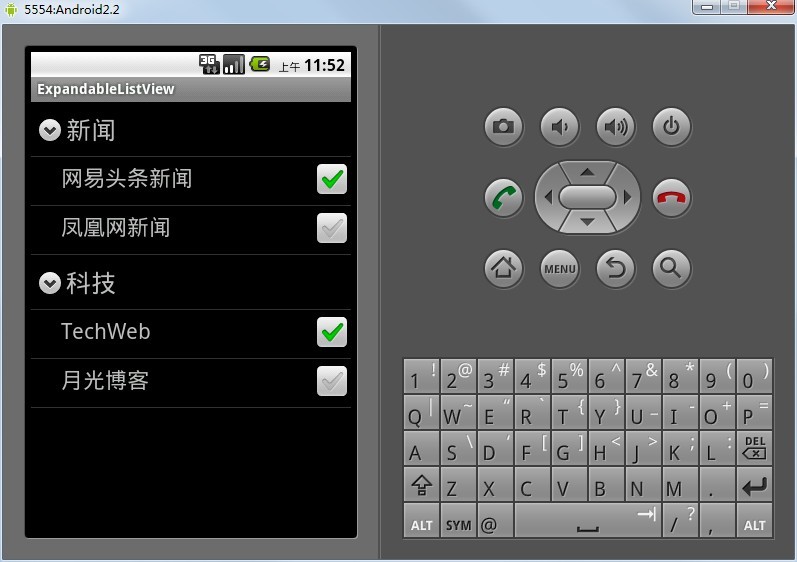Android开发之ExpandableListView扩展
来源:互联网 发布:js判断app安卓版本号 编辑:程序博客网 时间:2024/05/29 12:05
Android开发之ExpandableListView扩展(BaseExpandableListAdapter的使用)(完整版)
上一篇文章中谈到之前的代码中有一个问题。http://blog.csdn.net/benw1988/article/details/6871244

“程序本身还存在问题,checkbox在点击修改了状态之后,缩小组,在展开组,checkbox的状态会还原。
这是因为,在点击展开时,会重新调用getChildView函数,于是子列表的中的数据重新初始化了。所以数据就还原了。
因此,这个位置的代码还需要修改。才能满足要求。”
这一次修改之后,解决了这个问题,当然对源代码进行了一些修改。
在ExpandableListActivity中的onChildClick事件中进行了部分操作。
- CheckBox c = (CheckBox) v.getTag();
- c.toggle();
- adapter.updateChildData(groupPosition, childPosition);
- return super.onChildClick(parent, v, groupPosition, childPosition, id);
首先得到在Adapter中标记的Checkbox。(View中的setTag(Onbect)表示给View添加一个格外的数据,以后可以用getTag()将这个数据取出来。)
然后设置Checkbox点击。
然后再修改adapter中的ChildData也就是子列表里数据。所以,相应的在Adapter中也进行了修改:
- private void bindChildView(View view, Map<String, ?> data, String[] from,
- int[] to) {
- TextView v = (TextView) view.findViewById(to[0]);
- if (v != null) {
- v.setText((String) data.get(from[0]));
- }
- CheckBox c = (CheckBox) view.findViewById(to[1]);
- // View中的setTag(Onbect)表示给View添加一个格外的数据,以后可以用getTag()将这个数据取出来。
- view.setTag(c);
- if (c != null) {
- if (data.get(from[1]).equals(0)) {
- c.setChecked(true);
- } else {
- c.setChecked(false);
- }
- }
- }
updateChildData函数如下:
- public void updateChildData(int groupPosition, int childPosition) {
- int checked = (Integer) mChildData.get(groupPosition)
- .get(childPosition).get("childCheckBox");
- mChildData.get(groupPosition).get(childPosition)
- .remove("childCheckBox");
- if (checked == 0) {
- mChildData.get(groupPosition).get(childPosition)
- .put("childCheckBox", 1);
- } else if (checked == 1) {
- mChildData.get(groupPosition).get(childPosition)
- .put("childCheckBox", 0);
- }
- }
因为使用的是Map,不能直接修改里面的数据,所以先获取Map中childCheckBox里面的值
然后删除这个映射,根据原来的这个值,重新添加一个新的映射进去。
为了可以让Activity中的onChildClick事件得到响应,我们需要将Checkbox的焦点去掉。
在childs.xml的CheckBox中加入三个属性:
- android:clickable="false"
- android:focusable="false"
- android:focusableInTouchMode="false"
这样之后,就可以解决上面说的那个问题。
layout/main.xml
- <?xml version="1.0" encoding="utf-8"?>
- <LinearLayout xmlns:android="http://schemas.android.com/apk/res/android"
- android:orientation="vertical"
- android:layout_width="fill_parent"
- android:layout_height="fill_parent">
- <ExpandableListView
- android:id="@id/android:list"
- android:layout_width="fill_parent"
- android:layout_height="fill_parent">
- </ExpandableListView>
- <TextView
- android:layout_width="fill_parent"
- android:layout_height="fill_parent"
- android:id="@id/android:empty"
- android:text="No Data" />
- </LinearLayout>
layout/groups.xml
- <?xml version="1.0" encoding="utf-8"?>
- <LinearLayout xmlns:android="http://schemas.android.com/apk/res/android"
- android:orientation="vertical"
- android:layout_width="match_parent"
- android:layout_height="match_parent">
- <TextView
- android:id="@+id/groupTextView"
- android:layout_width="fill_parent"
- android:layout_height="fill_parent"
- android:textSize="25sp"
- android:paddingLeft="35px"
- android:paddingTop="10px"
- android:paddingRight="5px"
- android:paddingBottom="10px"
- android:text="No Data" />
- </LinearLayout>
layout/childs.xml
- <?xml version="1.0" encoding="utf-8"?>
- <RelativeLayout xmlns:android="http://schemas.android.com/apk/res/android"
- android:layout_width="match_parent"
- android:layout_height="match_parent">
- <TextView
- android:id="@+id/childTextView"
- android:layout_width="wrap_content"
- android:layout_height="match_parent"
- android:layout_alignParentLeft="true"
- android:textSize="22sp"
- android:layout_marginLeft="30dip"
- android:layout_marginTop="5dip"
- android:text="No Data" />
- <CheckBox
- android:id="@+id/childCheckBox"
- android:layout_width="wrap_content"
- android:layout_height="match_parent"
- android:layout_alignParentRight="true"
- android:layout_marginLeft="50dip"
- android:clickable="false"
- android:focusable="false"
- android:focusableInTouchMode="false"/>
- </RelativeLayout>
主类:ExpandableListViewActivity.java
- package com.zeph.android.expandablelistview.example;
- import java.util.ArrayList;
- import java.util.HashMap;
- import java.util.List;
- import java.util.Map;
- import android.app.ExpandableListActivity;
- import android.os.Bundle;
- import android.view.View;
- import android.widget.CheckBox;
- import android.widget.ExpandableListView;
- public class ExpandableListViewActivity extends ExpandableListActivity {
- private MyExpandableListViewAdapter adapter;
- @Override
- public void onCreate(Bundle savedInstanceState) {
- super.onCreate(savedInstanceState);
- setContentView(R.layout.main);
- // 创建两个一级条目标题
- List<Map<String, String>> groupData = new ArrayList<Map<String, String>>();
- Map<String, String> groupData1 = new HashMap<String, String>();
- groupData1.put("groupTextView", "新闻");// group对应layout中的id:group
- Map<String, String> groupData2 = new HashMap<String, String>();
- groupData2.put("groupTextView", "科技");
- groupData.add(groupData1);
- groupData.add(groupData2);
- // 创建第一个一级条目下的的二级条目
- List<Map<String, Object>> child1 = new ArrayList<Map<String, Object>>();
- Map<String, Object> childData1 = new HashMap<String, Object>();
- childData1.put("childTextView", "网易头条新闻");// 同理
- childData1.put("childCheckBox", 0);// 同理
- Map<String, Object> childData2 = new HashMap<String, Object>();
- childData2.put("childTextView", "凤凰网新闻");
- childData2.put("childCheckBox", 0);
- child1.add(childData1);
- child1.add(childData2);
- // 创建第二个一级条目下的的二级条目
- List<Map<String, Object>> child2 = new ArrayList<Map<String, Object>>();
- Map<String, Object> childData3 = new HashMap<String, Object>();
- childData3.put("childTextView", "TechWeb");
- childData3.put("childCheckBox", 1);
- Map<String, Object> childData4 = new HashMap<String, Object>();
- childData4.put("childTextView", "月光博客");
- childData4.put("childCheckBox", 1);
- child2.add(childData3);
- child2.add(childData4);
- // 将二级条目放在一个集合里,供显示时使用
- List<List<Map<String, Object>>> childData = new ArrayList<List<Map<String, Object>>>();
- childData.add(child1);
- childData.add(child2);
- adapter = new MyExpandableListViewAdapter(getApplicationContext(),
- groupData, R.layout.groups, new String[] { "groupTextView" },
- new int[] { R.id.groupTextView }, childData, R.layout.childs,
- new String[] { "childTextView", "childCheckBox" }, new int[] {
- R.id.childTextView, R.id.childCheckBox });
- setListAdapter(adapter);
- }
- /**
- * 设置哪个二级目录被默认选中
- */
- @Override
- public boolean setSelectedChild(int groupPosition, int childPosition,
- boolean shouldExpandGroup) {
- // do something
- return super.setSelectedChild(groupPosition, childPosition,
- shouldExpandGroup);
- }
- /**
- * 设置哪个一级目录被默认选中
- */
- @Override
- public void setSelectedGroup(int groupPosition) {
- // do something
- super.setSelectedGroup(groupPosition);
- }
- /**
- * 当二级条目被点击时响应
- */
- @Override
- public boolean onChildClick(ExpandableListView parent, View v,
- int groupPosition, int childPosition, long id) {
- CheckBox c = (CheckBox) v.getTag();
- c.toggle();
- adapter.updateChildData(groupPosition, childPosition);
- return super.onChildClick(parent, v, groupPosition, childPosition, id);
- }
- }
Adapter:MyExpandableListViewAdapter.java
- package com.zeph.android.expandablelistview.example;
- import java.util.List;
- import java.util.Map;
- import android.content.Context;
- import android.view.LayoutInflater;
- import android.view.View;
- import android.view.ViewGroup;
- import android.widget.BaseExpandableListAdapter;
- import android.widget.CheckBox;
- import android.widget.TextView;
- /**
- * 首个List对应子元素中所代表的组,第二个List对应孙子元素在子元素组中的位置. Map亦将支持这样的特殊元素。(子元素嵌套组元素的情况)
- * 将XML文件中定义的静态数据映射到组及其视图的简单的适配器. 你可以用 Map的列表,为组指定其后台数据。每个数组元素对应一个可展开列表的一个组。
- * Maps 包含每行的数据。你还可以指定 XML 文件来定义用于显示组的视图, 并通过 Map 的键值映射到指定的视图。该过程适用于组的子元素。
- * 单级以外的可展开列表的后台数据类型为List<List<Map>>,
- * 第一级列表对应可扩展视图组中的组视图,第二级列表对应组的子组视图, 最后 Map 保持子组视图的子视图的数据。
- *
- * @author BenZeph (以下代码和注释均参考了工具屋,网址:http://code.google.com/p/toolib/)
- */
- public class MyExpandableListViewAdapter extends BaseExpandableListAdapter {
- private List<? extends Map<String, ?>> mGroupData;
- private int mExpandedGroupLayout;
- private int mCollapsedGroupLayout;
- private String[] mGroupFrom;
- private int[] mGroupTo;
- private List<? extends List<? extends Map<String, Object>>> mChildData;
- private int mChildLayout;
- private int mLastChildLayout;
- private String[] mChildFrom;
- private int[] mChildTo;
- private LayoutInflater mInflater;
- /**
- * 调用另外一个构造函数,其中From和To的含义和不同的ListView相同,
- * 可以参考ListView或者SimpleExpandableListViewAdapter
- *
- * @param context
- * @param groupData
- * @param groupLayout
- * @param groupFrom
- * @param groupTo
- * @param childData
- * @param childLayout
- * @param childFrom
- * @param childTo
- */
- public MyExpandableListViewAdapter(Context context,
- List<? extends Map<String, ?>> groupData, int groupLayout,
- String[] groupFrom, int[] groupTo,
- List<? extends List<? extends Map<String, Object>>> childData,
- int childLayout, String[] childFrom, int[] childTo) {
- this(context, groupData, groupLayout, groupLayout, groupFrom, groupTo,
- childData, childLayout, childLayout, childFrom, childTo);
- }
- /**
- *
- * @param context
- * @param groupData
- * @param expandedGroupLayout
- * @param collapsedGroupLayout
- * @param groupFrom
- * @param groupTo
- * @param childData
- * @param childLayout
- * @param lastChildLayout
- * @param childFrom
- * @param childTo
- */
- public MyExpandableListViewAdapter(Context context,
- List<? extends Map<String, ?>> groupData, int expandedGroupLayout,
- int collapsedGroupLayout, String[] groupFrom, int[] groupTo,
- List<? extends List<? extends Map<String, Object>>> childData,
- int childLayout, int lastChildLayout, String[] childFrom,
- int[] childTo) {
- mGroupData = groupData;
- mExpandedGroupLayout = expandedGroupLayout;
- mCollapsedGroupLayout = collapsedGroupLayout;
- mGroupFrom = groupFrom;
- mGroupTo = groupTo;
- mChildData = childData;
- mChildLayout = childLayout;
- mLastChildLayout = lastChildLayout;
- mChildFrom = childFrom;
- mChildTo = childTo;
- mInflater = (LayoutInflater) context
- .getSystemService(Context.LAYOUT_INFLATER_SERVICE);
- }
- @Override
- public Object getChild(int groupPosition, int childPosition) {
- // 取得与指定分组、指定子项目关联的数据。
- return mChildData.get(groupPosition).get(childPosition);
- }
- @Override
- public long getChildId(int groupPosition, int childPosition) {
- // 取得给定分组中给定子视图的ID。 该组ID必须在组中是唯一的。组合的ID (参见getCombinedGroupId(long))
- // 必须不同于其他所有ID(分组及子项目的ID)。
- return childPosition;
- }
- @Override
- public View getChildView(int groupPosition, int childPosition,
- boolean isLastChild, View convertView, ViewGroup parent) {
- // 取得显示给定分组给定子位置的数据用的视图。
- View v;
- if (convertView == null) {
- v = newChildView(isLastChild, parent);
- } else {
- v = convertView;
- }
- bindChildView(v, mChildData.get(groupPosition).get(childPosition),
- mChildFrom, mChildTo);
- return v;
- }
- @Override
- public int getChildrenCount(int groupPosition) {
- // 取得指定分组的子元素数。
- return mChildData.get(groupPosition).size();
- }
- @Override
- public Object getGroup(int groupPosition) {
- // 取得与给定分组关联的数据。
- return mGroupData.get(groupPosition);
- }
- @Override
- public int getGroupCount() {
- // 取得分组数
- return mChildData.size();
- }
- @Override
- public long getGroupId(int groupPosition) {
- // 取得指定分组的ID。该组ID必须在组中是唯一的。组合的ID (参见getCombinedGroupId(long))
- // 必须不同于其他所有ID(分组及子项目的ID)。
- return groupPosition;
- }
- @Override
- public View getGroupView(int groupPosition, boolean isExpanded,
- View convertView, ViewGroup parent) {
- // 取得用于显示给定分组的视图。 这个方法仅返回分组的视图对象, 要想获取子元素的视图对象,
- // 就需要调用 getChildView(int, int, boolean, View, ViewGroup)。
- View v;
- if (convertView == null) {
- v = newGroupView(isExpanded, parent);
- } else {
- v = convertView;
- }
- bindGroupView(v, mGroupData.get(groupPosition), mGroupFrom, mGroupTo);
- return v;
- }
- @Override
- public boolean hasStableIds() {
- // 是否指定分组视图及其子视图的ID对应的后台数据改变也会保持该ID。
- return true;
- }
- @Override
- public boolean isChildSelectable(int groupPosition, int childPosition) {
- // 指定位置的子视图是否可选择。
- return true;
- }
- /**
- * 创建新的组视图
- *
- * @param isExpanded
- * @param parent
- * @return
- */
- public View newGroupView(boolean isExpanded, ViewGroup parent) {
- return mInflater.inflate((isExpanded) ? mExpandedGroupLayout
- : mCollapsedGroupLayout, parent, false);
- }
- /**
- * 创建新的子视图
- *
- * @param isLastChild
- * @param parent
- * @return
- */
- public View newChildView(boolean isLastChild, ViewGroup parent) {
- return mInflater.inflate((isLastChild) ? mLastChildLayout
- : mChildLayout, parent, false);
- }
- /**
- * 绑定组数据
- *
- * @param view
- * @param data
- * @param from
- * @param to
- */
- private void bindGroupView(View view, Map<String, ?> data, String[] from,
- int[] to) {
- // 绑定组视图的数据,针对Group的Layout都是TextView的情况
- int len = to.length;
- for (int i = 0; i < len; i++) {
- TextView v = (TextView) view.findViewById(to[i]);
- if (v != null) {
- v.setText((String) data.get(from[i]));
- }
- }
- }
- /**
- * 绑定子数据
- *
- * @param view
- * @param data
- * @param from
- * @param to
- */
- private void bindChildView(View view, Map<String, ?> data, String[] from,
- int[] to) {
- TextView v = (TextView) view.findViewById(to[0]);
- if (v != null) {
- v.setText((String) data.get(from[0]));
- }
- CheckBox c = (CheckBox) view.findViewById(to[1]);
- // View中的setTag(Onbect)表示给View添加一个格外的数据,以后可以用getTag()将这个数据取出来。
- view.setTag(c);
- if (c != null) {
- if (data.get(from[1]).equals(0)) {
- c.setChecked(true);
- } else {
- c.setChecked(false);
- }
- }
- }
- public void updateChildData(int groupPosition, int childPosition) {
- int checked = (Integer) mChildData.get(groupPosition)
- .get(childPosition).get("childCheckBox");
- mChildData.get(groupPosition).get(childPosition)
- .remove("childCheckBox");
- if (checked == 0) {
- mChildData.get(groupPosition).get(childPosition)
- .put("childCheckBox", 1);
- } else if (checked == 1) {
- mChildData.get(groupPosition).get(childPosition)
- .put("childCheckBox", 0);
- }
- }
- }
- Android开发之ExpandableListView扩展
- Android开发之ExpandableListView
- Android开发之ExpandableListView
- Android开发之ExpandableListView
- Android开发之ExpandableListView
- Android开发之ExpandableListView
- Android开发之ExpandableListView扩展(BaseExpandableListAdapter的使用)(完整版)
- Android开发之ExpandableListView扩展(BaseExpandableListAdapter的使用)(完整版)
- android开发之--ExpandableListView控件使用心得
- android ExpandableListView可扩展列表
- android ExpandableListView可扩展列表
- android ExpandableListView (可扩展ListView)
- Android ExpandableListView开发简介
- Android控件之ExpandableListView
- Android之ExpandableListView
- Android控件之ExpandableListView
- Android控件之ExpandableListView
- Android控件之ExpandableListView
- Python的WSGI
- CocoaPods安装及使用
- 多校第九场Arithmetic Sequence题解
- Java 程序优化:字符串操作、基本运算方法等优化策略
- 直接插入排序
- Android开发之ExpandableListView扩展
- mybatis中的trim
- 蒙特卡罗模拟(使用随机数和概率来解决问题)
- UML类图实例
- try catch finally return
- Introduction to Java Programming编程题5.13<数列求和>
- C语言格式化输出(整理2)
- 14. CSS 列表
- 分类与回归区别是什么?


